Antibody data
- Antibody Data
- Antigen structure
- References [0]
- Comments [0]
- Validations
- Western blot [5]
- Immunohistochemistry [2]
- Other assay [1]
Submit
Validation data
Reference
Comment
Report error
- Product number
- PA5-42441 - Provider product page

- Provider
- Invitrogen Antibodies
- Product name
- SLC33A1 Polyclonal Antibody
- Antibody type
- Polyclonal
- Antigen
- Synthetic peptide
- Description
- Peptide sequence: CNSVGQTAGY FLGNVLFLAL ESADFCNKYL RFQPQPRGIV TLSDFLFFWG Sequence homology: Cow: 93%; Dog: 93%; Guinea Pig: 93%; Horse: 100%; Human: 100%; Mouse: 100%; Rabbit: 100%; Rat: 100%; Zebrafish: 86%
- Reactivity
- Human
- Host
- Rabbit
- Isotype
- IgG
- Vial size
- 100 μL
- Concentration
- 0.5 mg/mL
- Storage
- -20°C, Avoid Freeze/Thaw Cycles
No comments: Submit comment
Supportive validation
- Submitted by
- Invitrogen Antibodies (provider)
- Main image
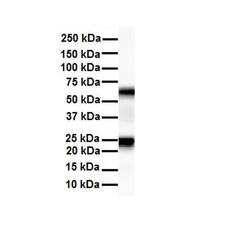
- Experimental details
- Western blot analysis of human liver cells using an anti-SLC33A1 polyclonal antibody (Product # PA5-42441).
- Submitted by
- Invitrogen Antibodies (provider)
- Main image
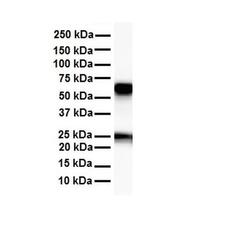
- Experimental details
- Western blot analysis of human heart cells using an anti-SLC33A1 polyclonal antibody (Product # PA5-42441).
- Submitted by
- Invitrogen Antibodies (provider)
- Main image
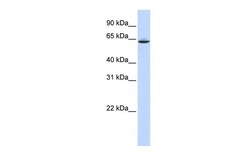
- Experimental details
- Western blot analysis of human placenta cells using an anti-SLC33A1 polyclonal antibody (Product # PA5-42441).
- Submitted by
- Invitrogen Antibodies (provider)
- Main image
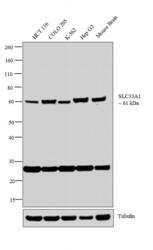
- Experimental details
- Western blot analysis was performed on whole cell extracts (30 µg lysate) of HCT 116 (Lane 1), COLO 205 (Lane 2), K-562 (Lane 3), Hep G2 (Lane 4) and tissue extract of Mouse Brain (Lane 5). The blot was probed with Anti-SLC33A1 Polyclonal Antibody (Product # PA5-42441, 0.5 µg/mL) and detected by chemiluminescence using Goat anti-Rabbit IgG (Heavy Chain) Superclonal™ Secondary Antibody, HRP conjugate (Product # A27036, 0.25 µg/mL, 1:4,000 dilution). A 61 kDa band corresponding to SLC33A1 was observed across the cell lines tested. An additional band around 26 kDa was observed in the cell lines tested.
- Submitted by
- Invitrogen Antibodies (provider)
- Main image
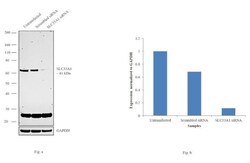
- Experimental details
- Knockdown of SLC33A1 was achieved by transfecting He pG2 cells with SLC33A1 specific siRNAs (Silencer® select Product # s17580, s17579). Western blot analysis (Fig. a) was performed using membrane enriched extracts from the SLC33A1 knockdown cells (lane 3), non-specific scrambled siRNA transfected cells (lane 2) and untransfected cells (lane 1). The blot was probed with SLC33A1 Polyclonal Antibody (Product # PA5-42441, 1:1,000 dilution) and Goat anti-Rabbit IgG (Heavy Chain) Superclonal™ Secondary Antibody, HRP conjugate (Product # A27036, 0.25 µg/mL, 1:4,000 dilution). Densitometric analysis of this western blot is shown in histogram (Fig. b). Decrease in signal upon siRNA mediated knock down confirms that antibody is specific to SLC33A1.
Supportive validation
- Submitted by
- Invitrogen Antibodies (provider)
- Main image

- Experimental details
- Immunohistochemistry (paraffin-embedded) analysis of human adult heart tissue using an anti-SLC33A1 polyclonal antibody (Product # PA5-42441).
- Submitted by
- Invitrogen Antibodies (provider)
- Main image
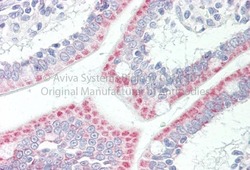
- Experimental details
- Immunohistochemistry (paraffin-embedded) analysis of human adult small intestine tissue using an anti-SLC33A1 polyclonal antibody (Product # PA5-42441).
Supportive validation
- Submitted by
- Invitrogen Antibodies (provider)
- Main image
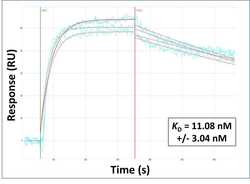
- Experimental details
- Surface Plasmon Resonance of SLC33A1 polyclonal antibody (Product # PA5-42441). Purified polyclonal antibodies were immobilized on a Protein A/G coated Carterra LSA sensor chip at concentrations of 5, and 50 µg/mL in duplicate. Antibodies on the surface were exposed to interaction with peptides sequentially via microfluidic controlled flow at 333 nm peptide concentration for kinetic characterization of the binders for affinity and specificity, followed by curve fitting using the Kinetics software. Kd determinations for both concentrations were averaged and results and standard deviation are shown.
 Explore
Explore Validate
Validate Learn
Learn Western blot
Western blot